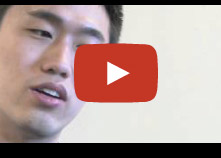Redefining Diversity in Broader Multicultural Terms
P&S students took breaks from their studies in recent months to learn Chinese calligraphy and paper cutting techniques, join in traditional Indian dances, and listen to an all-female mariachi band while sampling locally made Dominican food, part of an effort to raise student awareness of different cultures.
It is part of a “rebranding” of the P&S diversity office into a place where students from throughout the medical center can organize activities that will allow them to experience, celebrate, and appreciate the multicultural nature of their classmates, patients, and neighbors. Previously focused on underrepresented minority affairs, the office now has a broader reach and a new name: the Office of Diversity and Multicultural Affairs.
“Students told us that that they would like us to expand our programming to include even more cultures within the medical center community. We’re starting to address their needs in a more comprehensive way,” says Hilda Hutcherson, MD, P&S associate dean for diversity and multicultural affairs and professor of obstetrics & gynecology.
Starting last fall, Dr. Hutcherson and her team reached out to several student cultural and spiritual groups and offered to cosponsor events. Most of the ideas for programming originate with student groups, and the staff of the Office of Diversity and Multicultural Affairs provides funding and assistance to plan, promote, and run each event.
“We’re giving medical, dental, nursing, public health, and PhD students the chance to come together, learn about each other, and have fun together. There aren’t too many opportunities on campus for that to occur,” says Dr. Hutcherson.
One of the popular recent gatherings was a celebration of Diwali, the Hindu Festival of Lights. Held last October, it was presented by the South Asian Health Sciences Association and showcased cultures from all over India through food, dance, and henna painting.
The Medical Center Jewish Association also has hosted programs, including a kosher Shabbat dinner last September that drew more than 150 CUMC students. Lauren Arnold’16, who was co-president of the association for 2012-2013, explained the Shabbat rituals and answered questions at the dinner. “Many of the people who attended had never tried kosher food or celebrated Shabbat before,” Ms. Arnold says. “They said we created a welcoming space for them to learn while having a good time.”
 Lunar New Year Celebration
Lunar New Year Celebration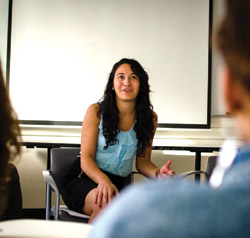 Me Too Monologues
Me Too Monologues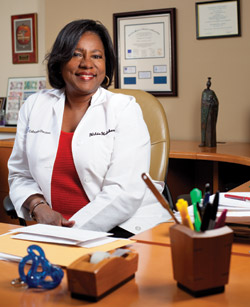 Hilda Hutcherson, MD
Hilda Hutcherson, MD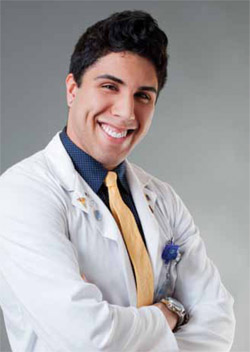 Michael Hernandez’17
Michael Hernandez’17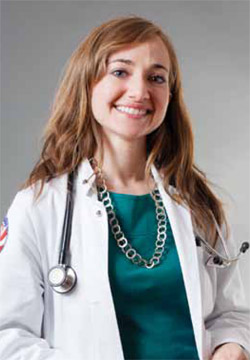 Lauren Arnold’16
Lauren Arnold’16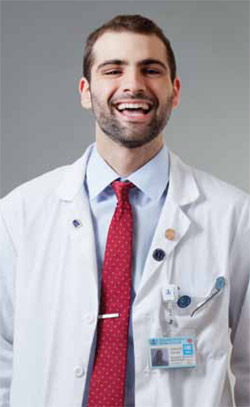 Christopher J. Gonzalez’16
Christopher J. Gonzalez’16 Steven Li’17
Steven Li’17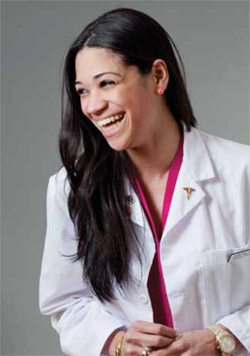 Pliceliany Perez’17
Pliceliany Perez’17Later in the fall, the group hosted a talk on Jewish medical ethics by Kenneth Prager, MD, chair of the NewYork-Presbyterian Medical Ethics Committee and professor of medicine. Dr. Prager discussed how rabbinic law applies to medical practice and end-of-life care.
Students from across campus also attended a talk last September called “Trans Health 101” presented by the Lambda Health Alliance, an organization that provides support and programming for gay, lesbian, bisexual, transsexual, and queer students and faculty. Dr. Laura Erickson-Schroth, editor of the book “Trans Bodies, Trans Selves,” spoke about the health issues faced by transgender people and the role of professionals in providing health care to transgender patients.
Many of the events now supported by the Office of Diversity and Multicultural Affairs have been traditions at Columbia—Columbia Hispanic Heritage Month and the Lunar New Year Celebration, for example—but now have been expanded to include participants from outside the individual organizations.
In addition to supporting existing events, the Office of Diversity and Multicultural Affairs also supports new events, including this spring’s theatrical production called “Me Too Monologues.” The production was staged to give students a safe forum to share their personal stories centered on concepts of identity, including race, gender, sexuality, religion, class, and nationality. “Me Too Monologues” was intended to celebrate individual experiences in hope of finding common ground, says Steven Li’17, who directed the performance of student actors who brought to life stories that medical center students submitted anonymously.
Other new diversity initiatives focus on providing academic support to students. For example, to help new students prepare for their first semester at P&S, the Office of Diversity and Multicultural Affairs offered a pilot prematriculation program during the summer of 2013. Most of the students who participated in the two-week program had attended CUMC’s pipeline programs designed to enhance opportunities for underrepresented minority and socioeconomically disadvantaged high school and college students who aspire to careers in health care.
Members of BALSO—the Black and Latino Student Organization—who finished their first year at P&S taught the new students in the prematriculation program about the curriculum and shared tips on the transition to medical school.
“We learned about the core material we would be presented with during the first semester, study techniques, and pointers on what to focus on,” says Michael Hernandez’17. “I referred to the notes once school started and I appreciated that rising second-year students gave us reassurance that we could get through the first semester. It would be difficult, but it would be OK.”
The Office of Diversity and Multicultural Affairs will evaluate the prematriculation program to determine whether it helps boost academic performance.
Two members of the class of 2017 who were alumni of CUMC pipeline programs served as teaching assistants in two pipeline programs during the summer of 2013. Mr. Hernandez taught and mentored students in the Summer Medical and Dental Education Program (SMDEP), the six-week residential program offered at Columbia since 1989. Mr. Hernandez attended the program when he was a junior in college and credits it with teaching him how to apply to medical school. He says he valued the chance to offer reassurance to students preparing to go through that process.
Pliceliany Perez’17 served as teaching assistant for both the SMDEP and the Northeast Regional Alliance MedPrep Scholars Program. Intended to help socioeconomically disadvantaged college freshman and sophomores from New York City and New Jersey become more competitive in applying to medical school, NERA MedPrep is a six-week summer enrichment program. Students enroll in the program for three summers. Ms. Perez attended another pipeline program, P&S Strategic Testing Application Techniques, a four-month weekend academic enrichment program that also helps prepare college students to apply to medical school.
She keeps in touch with students she mentored over the summer and offers them encouragement and advice. “I want to give students who come from a background similar to my own the sense that it’s possible to get into medical school,” she says. “I tell them if I could do it, you can do it too.”
BALSO created an outreach program called Young Docs that targets elementary students in the community. Once a month, P&S student volunteers visit an under-resourced elementary school in Washington Heights or Inwood. Wearing white coats and carrying stethoscopes and skeleton models, they teach the students about the human body and what it is like to become a doctor.
“These students don’t necessarily have access to people who have been successful in the health sciences field,” says Danielle Pottinger’16.
“We’re trying to galvanize an interest in health sciences from an early age and offer ourselves as role models.”
Last December, Young Docs hosted its first science competition for high school students. Open to ninth and 10th graders from throughout New York City, the competition was held in Bard Hall and cosponsored by the Office of Diversity and Multicultural Affairs. Students signed up in teams of two and were asked to construct a 3D model of the human heart and label a hand-drawn schematic of the internal heart structure on a tri-fold poster board. They also chose a heart disease, explained its pathophysiology, and described a treatment for it. Trophies and cash prizes were awarded to the top three teams and all participants received medals.
“We thought it would be empowering for the students to come to the Columbia campus and meet faculty and administrators here. These people could be potential mentors and contacts for them in the future,” says Ms. Pottinger. She adds that BALSO would like to make the science competition an annual event and to expand it to include more student teams.
When applicants to P&S arrive on campus for interviews and return for a second look on revisit weekend, Dr. Hutcherson tells them about the school’s diversity initiatives and the many opportunities to get involved with community service activities, including Young Docs or pipeline programs. “Some students have said it’s one of the reasons they decided to enroll at P&S—the opportunities to give back to younger people who may not be as privileged as they are,” says Dr. Hutcherson.
Members of BALSO reach out to prospective students who self-identify on their applications as underrepresented minorities and meet with them when they visit campus.
“Me Too Monologues” gave students a forum to share their personal stories about identity, including race, gender, sexuality, religion, class, and nationality
“Students can see during interview day that there is a welcoming minority community here,” says Christopher J. Gonzalez’16, who served as president of BALSO for 2013.
More and more, leaders of individual cultural and spiritual organizations on campus are attending each other’s events and coming together to create events. Last December’s Taste of the World Night Market, for example, featured 20 student-curated tables with food and drinks from around the globe and drew more than 300 people.
Students provided tasting portions of such delicacies as Native American frybread, Armenian kebabs, noodle kugel, Jamaican jerk chicken and beef patties, Chinese spicy prawns, Egyptian stuffed grape leaves, Sudanese eggplant moolah, and Mexican hot chocolate. They also shared information on the cultural significance behind each dish.
“Using food as a stepping point from which to talk about our backgrounds was amazing,” says Ms. Arnold, one of the organizers of the event, held in Bard Hall. “I think the reason it was so successful is that five different student groups—the Asian Pacific American Medical Students Association, the Muslim Student Association, the South Asian Health Sciences Association, BALSO, and the Medical Center Jewish Association—came together with the Office of Diversity and Multicultural Affairs to work on it and that brought a lot of richness to the program.”
‘We are trying to train physicians and other health care providers to be more understanding of different cultures because the patients they will take care of will be of various cultures and backgrounds.’ — Hilda Hutcherson
Other events are being planned with the Association for Native American Health, the Columbia Christian Fellowship, and the CUMC Muslim Student Association. These events allow students to explore other cultures and begin a dialogue about cultural differences in a way that is fun and not intimidating. Dr. Hutcherson says one of the goals of the expanded Office of Diversity and Multicultural Affairs is to continue to support similar new programs that will help students develop cultural competence.
Anne Taylor, MD, the John Lindenbaum Professor of Medicine at CUMC and P&S vice dean for academic affairs, is a leader in faculty mentorship and at P&S is heading efforts to increase the numbers of women and underrepresented minorities in the faculty ranks. “Diversity encompasses much more than simple parameters of race/ethnicity and gender. It also includes culture/ethnicity, religious practices, disability status, sexual orientation, socioeconomic status, and other differences. The first person in a family to graduate from college and go on to medical school brings a different experience than someone who comes from a multigenerational family of professionals. Because P&S is a preeminent medical school with community, national, and global impact, educating our students in an environment that is inclusive prepares them to function in the global community. It clearly signals to the world that Columbia is a welcoming environment that enhances our ability to recruit the most talented students, trainees, and faculty in the world.”
“Our medical school and our medical center are judged by the impact our students and faculty have on people’s lives, either here on campus, in the community, or beyond,” says Dean Lee Goldman. “That impact will be richer and more diverse because the programs that Dr. Hutcherson has implemented will help students understand and experience cultures beyond their own. Everyone benefits from that engagement.”
“Ultimately, we are trying to train physicians and other health care providers to be more understanding of different cultures because the patients they will take care of will be of various cultures and backgrounds,” says Dr. Hutcherson. “And you have to feel comfortable taking care of everyone.”
- Log in to post comments



